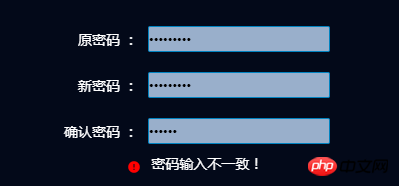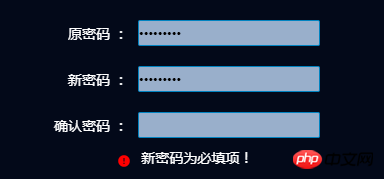如何操作Angular實作模版驅動表單的自訂校驗功能
這次帶給大家如何操作Angular實作模版驅動表單的自訂校驗功能,操作Angular實作模版驅動表單的自訂校驗功能的注意事項有哪些,以下就是實戰案例,一起來看一下。
HTML5原生的表單校驗屬性(必填,長度限制,取值間隔,正規表示式等等)可以滿足普通的校驗需求,但是有些場景必須用到自訂校驗,例如註冊時的密碼確認,有比對關係的時間/數值選擇, 需要到請求到服務端取值驗證等等···這裡以密碼確認為例進行說明。
指令開發
表單的驗證狀態是透過formContro l的errors 屬性回饋出來的,所以基本的思路肯定就是需要新增校驗規則,然後將驗證結果加入formControl實例的errors屬性。那麼問題來了,模版驅動表單的控制都是在HTML模版中完成的,無法直接接觸到 formControl實例。這時候就需要使用指令了,將檢驗規則包裝。 Angular提供了 驗證器供應商 NG_VALIDATORS ,用於處理表單自訂校驗。先創建指令。
import { Directive} from '@angular/core';
import { NG_VALIDATORS, Validator, AbstractControl} from '@angular/forms';
@Directive({
selector: '[appConfirmpsw]',
providers: [{
provide : NG_VALIDATORS,
useExisting : ConfirmpswDirective,
multi: true
}]
})
export class ConfirmpswDirective implements Validator {
constructor() {
}
validate(control: AbstractControl): {[key: string]: any} {
//检验规则
}
}1、指定供應商 NG_VALIDATORS , 和別名類別 ConfirmpswDirective , 及 multi 為true(可用同一個token,註冊不同的 provide)。因為是在 NG_VALIDATORS 提供者中註冊的指令,所以才能被Angular的驗證流程識別,需要注意的是要用useExisting來註冊,這樣就不會建立一個新的實例。
2、用 Validator介面來約束 自訂的指令,這是Angular提供的驗證器的類別 。有validate屬性,會傳入表單的formControl,傳回 ValidationErrors 物件。
現在指令結構完成,開始進行校驗部分。首先需要傳入已輸入的密碼,所以增加@input,再指定校驗規則,判斷綁定表單的值和傳入的已輸入值是否相同
@Input('appConfirmpsw') confirmpsw: string; 為了避免使用指令時,還需要額外傳入confirmpsw屬性( <input type="password" appConfirmpsw [confirmpsw]="'xxx'" >),所以我們將指令名稱appConfirmpsw作為confirmpsw的別名,這樣傳入值就會比較方便,簡化為 <input type="password" [appConfirmpsw] = "'xxx'">。
這裡專門寫一個檢驗函數,用來比對值和回傳結果。記得在指令的validate中呼叫一下
export function comfirmPswValidator(_confirmpsw: string): ValidatorFn { //传入已输入的密码值 , 返回一个ValidatorFn
return (control: AbstractControl): {[key: string]: any} => { //传入绑定表单的formControl
if ( !control.value ) { //如果绑定未输入值,则返回 required错误
return { 'required' : true };
}
//如果两次输入的值不相同,则返回confirmpsw的错误
return control.value !== _confirmpsw ? {'confirmpsw' : {value: true}} : null;
};
}完整指令如下:
import { Directive, Input } from '@angular/core';
import { NG_VALIDATORS, Validator, AbstractControl, ValidatorFn} from '@angular/forms';
@Directive({
selector: '[appConfirmpsw]',
providers: [{
provide : NG_VALIDATORS,
useExisting : ConfirmpswDirective,
multi: true
}]
})
export class ConfirmpswDirective implements Validator {
@Input('appConfirmpsw') confirmpsw: string;
constructor() {
}
validate(control: AbstractControl): {[key: string]: any} {
console.log(this.confirmpsw);
return this.confirmpsw ? comfirmPswValidator(this.confirmpsw)(control) : null;
}
}
export function comfirmPswValidator(_confirmpsw: string): ValidatorFn {
return (control: AbstractControl): {[key: string]: any} => {
if ( !control.value ) {
return { 'required' : true };
}
return control.value !== _confirmpsw ? {'confirmpsw' : {value: true}} : null;
};
}使用
# 測試指令的效果吧
<p class="input-group"> <label class="group-label" for="psw-new"> 新密码 :</label> <input class="group-input" [(ngModel)]="inputpsw.new" #new="ngModel" type="password" name="psw" id="psw-new" required> </p> <p class="input-group input-error" *ngIf="new.touched&&new.invalid"> <p class="group-error-content" *ngIf="new.errors?.required">确认密码为必填项!</p> </p> <p class="input-group"> <label class="group-label" for="psw-confirm">确认密码 :</label> <input class="group-input" [(ngModel)]="inputpsw.confirm" #confirm="ngModel" type="password" name="confirm" id="psw-confirm" [appConfirmpsw] = "new.value" required> </p> <p class="input-group input-error" *ngIf="confirm.touched&&confirm.invalid"> <p class="group-error-content" *ngIf="confirm.errors?.required">新密码为必填项!</p> <p class="group-error-content" *ngIf="confirm.errors?.confirmpsw">密码输入不一致!</p> </p>
傳入new表單的值,並透過errors.confirmpsw屬性來控制提示語回饋。密碼輸入不一致,可以正確的校驗到

確認密碼為空時的提示也正確

相信看了本文案例你已經掌握了方法,更多精彩請關注php中文網其它相關文章!
推薦閱讀:
#以上是如何操作Angular實作模版驅動表單的自訂校驗功能的詳細內容。更多資訊請關注PHP中文網其他相關文章!

熱AI工具

Undresser.AI Undress
人工智慧驅動的應用程序,用於創建逼真的裸體照片

AI Clothes Remover
用於從照片中去除衣服的線上人工智慧工具。

Undress AI Tool
免費脫衣圖片

Clothoff.io
AI脫衣器

Video Face Swap
使用我們完全免費的人工智慧換臉工具,輕鬆在任何影片中換臉!

熱門文章

熱工具

記事本++7.3.1
好用且免費的程式碼編輯器

SublimeText3漢化版
中文版,非常好用

禪工作室 13.0.1
強大的PHP整合開發環境

Dreamweaver CS6
視覺化網頁開發工具

SublimeText3 Mac版
神級程式碼編輯軟體(SublimeText3)
 華為手機如何實現雙微信登入?
Mar 24, 2024 am 11:27 AM
華為手機如何實現雙微信登入?
Mar 24, 2024 am 11:27 AM
華為手機如何實現雙微信登入?隨著社群媒體的興起,微信已成為人們日常生活中不可或缺的溝通工具之一。然而,許多人可能會遇到一個問題:在同一部手機上同時登入多個微信帳號。對於華為手機用戶來說,實現雙微信登入並不困難,本文將介紹華為手機如何實現雙微信登入的方法。首先,華為手機自帶的EMUI系統提供了一個很方便的功能-應用程式雙開。透過應用程式雙開功能,用戶可以在手機上同
 如何在Ubuntu 24.04上安裝Angular
Mar 23, 2024 pm 12:20 PM
如何在Ubuntu 24.04上安裝Angular
Mar 23, 2024 pm 12:20 PM
Angular.js是一種可自由存取的JavaScript平台,用於建立動態應用程式。它允許您透過擴展HTML的語法作為模板語言,以快速、清晰地表示應用程式的各個方面。 Angular.js提供了一系列工具,可協助您編寫、更新和測試程式碼。此外,它還提供了許多功能,如路由和表單管理。本指南將討論在Ubuntu24上安裝Angular的方法。首先,您需要安裝Node.js。 Node.js是一個基於ChromeV8引擎的JavaScript運行環境,可讓您在伺服器端執行JavaScript程式碼。要在Ub
 PHP程式設計指南:實作斐波那契數列的方法
Mar 20, 2024 pm 04:54 PM
PHP程式設計指南:實作斐波那契數列的方法
Mar 20, 2024 pm 04:54 PM
程式語言PHP是一種用於Web開發的強大工具,能夠支援多種不同的程式設計邏輯和演算法。其中,實作斐波那契數列是一個常見且經典的程式設計問題。在這篇文章中,將介紹如何使用PHP程式語言來實作斐波那契數列的方法,並附上具體的程式碼範例。斐波那契數列是一個數學上的序列,其定義如下:數列的第一個和第二個元素為1,從第三個元素開始,每個元素的值等於前兩個元素的和。數列的前幾元
 如何在華為手機上實現微信分身功能
Mar 24, 2024 pm 06:03 PM
如何在華為手機上實現微信分身功能
Mar 24, 2024 pm 06:03 PM
如何在華為手機上實現微信分身功能隨著社群軟體的普及和人們對隱私安全的日益重視,微信分身功能逐漸成為人們關注的焦點。微信分身功能可以幫助使用者在同一台手機上同時登入多個微信帳號,方便管理和使用。在華為手機上實現微信分身功能並不困難,只需要按照以下步驟操作即可。第一步:確保手機系統版本和微信版本符合要求首先,確保你的華為手機系統版本已更新至最新版本,以及微信App
 掌握Golang如何實現遊戲開發的可能性
Mar 16, 2024 pm 12:57 PM
掌握Golang如何實現遊戲開發的可能性
Mar 16, 2024 pm 12:57 PM
在現今的軟體開發領域中,Golang(Go語言)作為一種高效、簡潔、並發性強的程式語言,越來越受到開發者的青睞。其豐富的標準庫和高效的並發特性使它成為遊戲開發領域的一個備受關注的選擇。本文將探討如何利用Golang來實現遊戲開發,並透過具體的程式碼範例來展示其強大的可能性。 1.Golang在遊戲開發中的優勢作為靜態類型語言,Golang正在建構大型遊戲系統
 如何在Golang中實現精確除法運算
Feb 20, 2024 pm 10:51 PM
如何在Golang中實現精確除法運算
Feb 20, 2024 pm 10:51 PM
在Golang中實現精確除法運算是一個常見的需求,特別是在涉及金融計算或其它需要高精度計算的場景中。 Golang的內建的除法運算子「/」是針對浮點數計算的,並且有時會出現精度遺失的問題。為了解決這個問題,我們可以藉助第三方函式庫或自訂函數來實現精確除法運算。一種常見的方法是使用math/big套件中的Rat類型,它提供了分數的表示形式,可以用來實現精確的除法運算
 Angular元件及其顯示屬性:了解非block預設值
Mar 15, 2024 pm 04:51 PM
Angular元件及其顯示屬性:了解非block預設值
Mar 15, 2024 pm 04:51 PM
Angular框架中元件的預設顯示行為不是區塊級元素。這種設計選擇促進了元件樣式的封裝,並鼓勵開發人員有意識地定義每個元件的顯示方式。透過明確設定CSS屬性 display,Angular組件的顯示可以完全控制,從而實現所需的佈局和響應能力。
 PHP遊戲需求實作指南
Mar 11, 2024 am 08:45 AM
PHP遊戲需求實作指南
Mar 11, 2024 am 08:45 AM
PHP遊戲需求實現指南隨著網路的普及和發展,網頁遊戲的市場也越來越火爆。許多開發者希望利用PHP語言來開發自己的網頁遊戲,而實現遊戲需求是其中一個關鍵步驟。本文將介紹如何利用PHP語言來實現常見的遊戲需求,並提供具體的程式碼範例。 1.創造遊戲角色在網頁遊戲中,遊戲角色是非常重要的元素。我們需要定義遊戲角色的屬性,例如姓名、等級、經驗值等,並提供方法來操作這些






